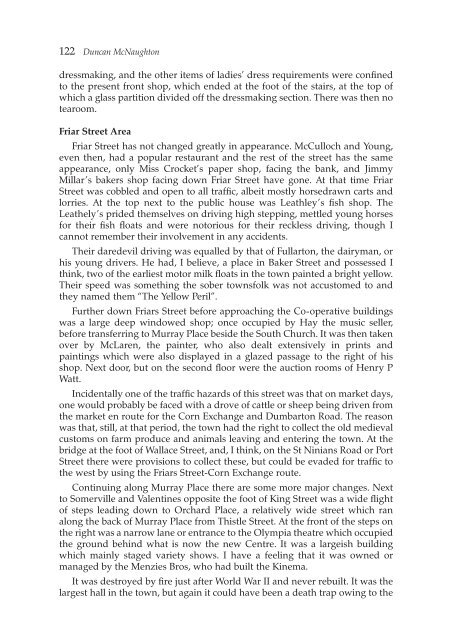the Forth Naturalist Historian - Forth Naturalist and Historian ...
the Forth Naturalist Historian - Forth Naturalist and Historian ...
the Forth Naturalist Historian - Forth Naturalist and Historian ...
You also want an ePaper? Increase the reach of your titles
YUMPU automatically turns print PDFs into web optimized ePapers that Google loves.
122 Duncan McNaughton<br />
dressmaking, <strong>and</strong> <strong>the</strong> o<strong>the</strong>r items of ladies’ dress requirements were confined<br />
to <strong>the</strong> present front shop, which ended at <strong>the</strong> foot of <strong>the</strong> stairs, at <strong>the</strong> top of<br />
which a glass partition divided off <strong>the</strong> dressmaking section. There was <strong>the</strong>n no<br />
tearoom.<br />
Friar Street Area<br />
Friar Street has not changed greatly in appearance. McCulloch <strong>and</strong> Young,<br />
even <strong>the</strong>n, had a popular restaurant <strong>and</strong> <strong>the</strong> rest of <strong>the</strong> street has <strong>the</strong> same<br />
appearance, only Miss Crocket’s paper shop, facing <strong>the</strong> bank, <strong>and</strong> Jimmy<br />
Millar’s bakers shop facing down Friar Street have gone. At that time Friar<br />
Street was cobbled <strong>and</strong> open to all traffic, albeit mostly horsedrawn carts <strong>and</strong><br />
lorries. At <strong>the</strong> top next to <strong>the</strong> public house was Leathley’s fish shop. The<br />
Lea<strong>the</strong>ly’s prided <strong>the</strong>mselves on driving high stepping, mettled young horses<br />
for <strong>the</strong>ir fish floats <strong>and</strong> were notorious for <strong>the</strong>ir reckless driving, though I<br />
cannot remember <strong>the</strong>ir involvement in any accidents.<br />
Their daredevil driving was equalled by that of Fullarton, <strong>the</strong> dairyman, or<br />
his young drivers. He had, I believe, a place in Baker Street <strong>and</strong> possessed I<br />
think, two of <strong>the</strong> earliest motor milk floats in <strong>the</strong> town painted a bright yellow.<br />
Their speed was something <strong>the</strong> sober townsfolk was not accustomed to <strong>and</strong><br />
<strong>the</strong>y named <strong>the</strong>m “The Yellow Peril”.<br />
Fur<strong>the</strong>r down Friars Street before approaching <strong>the</strong> Co-operative buildings<br />
was a large deep windowed shop; once occupied by Hay <strong>the</strong> music seller,<br />
before transferring to Murray Place beside <strong>the</strong> South Church. It was <strong>the</strong>n taken<br />
over by McLaren, <strong>the</strong> painter, who also dealt extensively in prints <strong>and</strong><br />
paintings which were also displayed in a glazed passage to <strong>the</strong> right of his<br />
shop. Next door, but on <strong>the</strong> second floor were <strong>the</strong> auction rooms of Henry P<br />
Watt.<br />
Incidentally one of <strong>the</strong> traffic hazards of this street was that on market days,<br />
one would probably be faced with a drove of cattle or sheep being driven from<br />
<strong>the</strong> market en route for <strong>the</strong> Corn Exchange <strong>and</strong> Dumbarton Road. The reason<br />
was that, still, at that period, <strong>the</strong> town had <strong>the</strong> right to collect <strong>the</strong> old medieval<br />
customs on farm produce <strong>and</strong> animals leaving <strong>and</strong> entering <strong>the</strong> town. At <strong>the</strong><br />
bridge at <strong>the</strong> foot of Wallace Street, <strong>and</strong>, I think, on <strong>the</strong> St Ninians Road or Port<br />
Street <strong>the</strong>re were provisions to collect <strong>the</strong>se, but could be evaded for traffic to<br />
<strong>the</strong> west by using <strong>the</strong> Friars Street-Corn Exchange route.<br />
Continuing along Murray Place <strong>the</strong>re are some more major changes. Next<br />
to Somerville <strong>and</strong> Valentines opposite <strong>the</strong> foot of King Street was a wide flight<br />
of steps leading down to Orchard Place, a relatively wide street which ran<br />
along <strong>the</strong> back of Murray Place from Thistle Street. At <strong>the</strong> front of <strong>the</strong> steps on<br />
<strong>the</strong> right was a narrow lane or entrance to <strong>the</strong> Olympia <strong>the</strong>atre which occupied<br />
<strong>the</strong> ground behind what is now <strong>the</strong> new Centre. It was a largeish building<br />
which mainly staged variety shows. I have a feeling that it was owned or<br />
managed by <strong>the</strong> Menzies Bros, who had built <strong>the</strong> Kinema.<br />
It was destroyed by fire just after World War II <strong>and</strong> never rebuilt. It was <strong>the</strong><br />
largest hall in <strong>the</strong> town, but again it could have been a death trap owing to <strong>the</strong>



